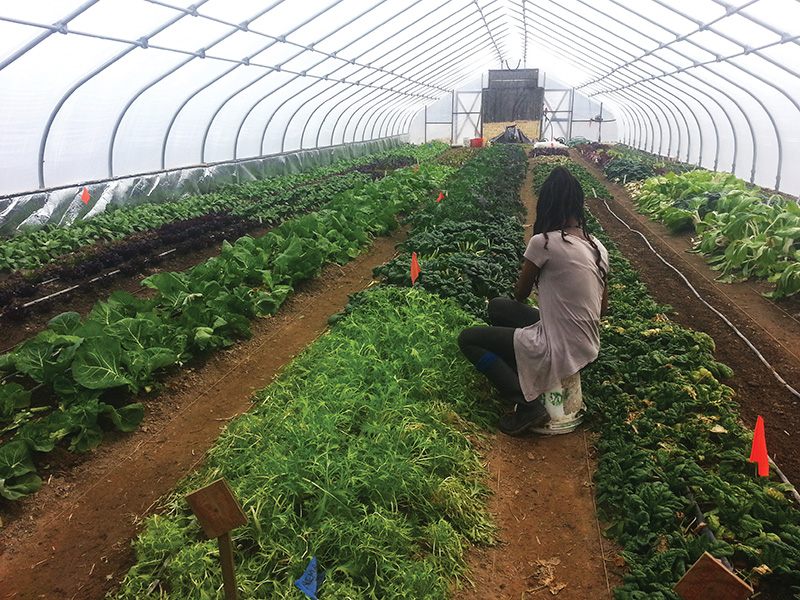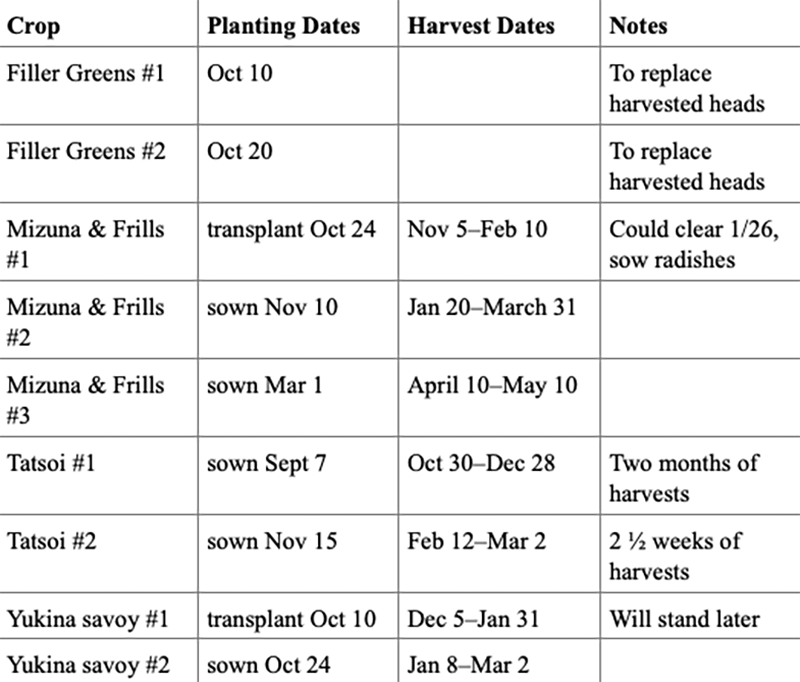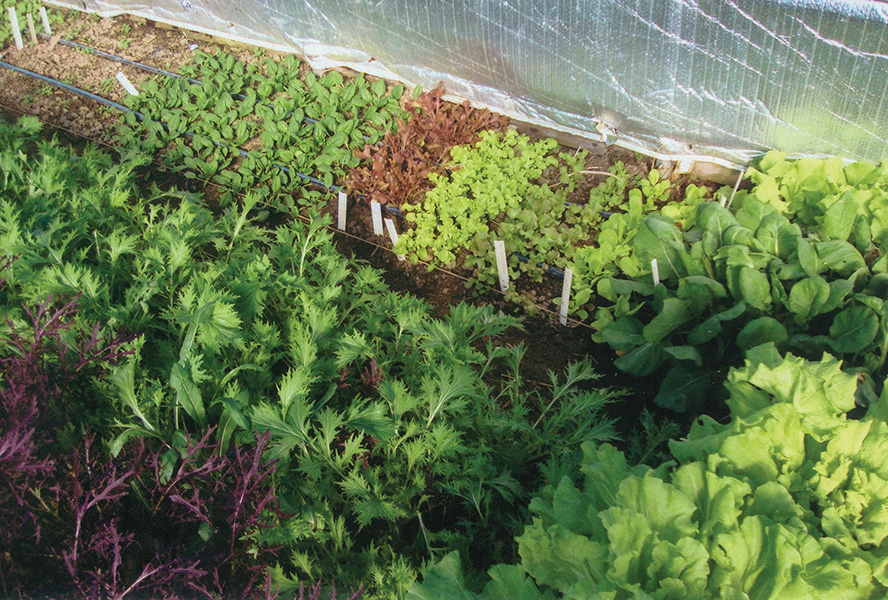Variety and versatility for much of the season
Asian greens include a huge range of plants in the brassica genus, with leaf colors from chartreuse (yellow-green), bright green and dark green to purple. Flavors vary from mild to peppery, so read catalog descriptions and choose according to how pungent you want your greens to taste. They are nutritious as well as tasty, being high in carotenoids, vitamins A and C, calcium, iron, magnesium and fiber. They help prevent high blood pressure, heart disease and stroke. They contain antioxidants which fight against cancer and protect eyes from macular degeneration.
Asian greens are quick-growing and easy. Grow them as if you are growing kale. The faster-growing types are ready for transplanting two weeks after sowing (or direct sow). In central Virginia where we are, they have a short spring season, and then bolt when it warms up, followed by a long fall season with no bolting. Success depends on getting them germinated and planted in summer. They grow all winter in our hoop house.
 A worker harvesting mizuna in our hoophouse in January. No coat needed! Photo by Wren Vile.
A worker harvesting mizuna in our hoophouse in January. No coat needed! Photo by Wren Vile.
They provide a catch crop for spaces where other crops have failed or otherwise finished early. Keep a flat of seedlings ready, pop plugs into any empty spaces, or sow a short row for bare-root transplants. When searching seed catalogs, try the word “mustard.” Kitazawa Seed Company and Evergreen Seeds have the most choices, although many are now widely available. See the list of recommended crops on page 11.
Crop requirements
Asian greens require conditions very similar to other brassicas, making life easy. Grow them all the same way but you get lots of different crops. Very fertile soils grow the best Asian greens, use legume cover crops or compost to provide adequate nutrition. Closely monitor pests. Asian greens are shallow-rooted. Provide 1” (2.5 cm) of water per week, 2” (5 cm) during very hot weather to prevent bitter flavors and excess pungency. Drip irrigation saves water and reduces disease and weed pressure, but sprinklers are cheaper, easier to set up and can wash off aphids — maybe all the control you need.
You can direct sow or transplant. We grow a lot of brassicas and our crop rotation is always stretched by the amount of brassicas we’d like to plant. Transplanting allows the soil a few extra weeks without brassicas.
Transplanting also gives the previous crop extra time. If we have four weeks between the end of one crop and transplants going in, we sow buckwheat to add organic matter and smother weeds. We usually choose this cover crop opportunity rather than directly sowing greens.
Spring
Our spring is short for Asian greens; they bolt, sometimes before reaching full-size. We start very early and don’t plant many. We sow in flats and transplant at four to five weeks, at least a month before the last frost date, using row cover for a few weeks. The order of bolting of (overwintered) Asian greens in spring is: tatsoi, ‘Maruba Santoh,’ ‘Tokyo Bekana,’ ‘Koji,’ Napa cabbage, pak choy, Yukina savoy, komatsuna, mizuna, leaf radish.
Summer lettuce substitutes
Provided you can keep bugs off and supply enough water, ‘Tokyo Bekana’ and ‘Maruba Santoh’ will provide mild-flavored salads during summer lettuce shortages. Asian greens germinate at higher temperatures than lettuce, emerge sooner and grow quicker. Most people don’t notice they’re not eating lettuce. In Jamaica and Cuba I saw these crops grown regularly as “summer lettuce,” although when questioned, the growers confirmed they were a kind of Chinese cabbage.
Season extension in hot weather
Asian greens can germinate in temperatures up to 95°F (35°C). Use shade cloth to keep crops cool and netting to keep pests off. Nets are better than row cover in hot weather, as airflow is better and heating is less. Dubois Agrinovation has a range of ProtekNet Insect Exclusion Netting, made of clear high-density knitted polyamide (lighter weights), polypropylene/olefin (mid-weight) or polyethylene (heavy weights) with UV resistance. Be sure to buy the size mesh that keeps out the pest you are guarding against. See the Dimensions and Specifications tab on their website. We have bought the 0.0335” x 0.0335” (0.85 mm x 0.85 mm) mesh (against harlequin bugs) and the 0.0138” x 0.0138” (0.35 mm x 0.35 mm) mesh against flea beetles. Pieces can be sewn together, or Dubois will join them with zippers. See the “details” tab on the Dubois website for the insects excluded by each particular mesh. Light transmission is 88 to 93 percent. Ours have lasted many years, longer than row cover. Use hoops to hold the mesh above the plants so insects can’t lay eggs through the holes. Purple Mountain Organics sell the whole range in full rolls, and the 25g in 6.9’ x 33’. Johnny’s Selected Seeds sells 6.9’ x 328’ 25g “Thrips Net.” Compare shipping charges as well as netting price.
 The author’s winter planting and harvest dates.
The author’s winter planting and harvest dates.
Summer and fall outdoor crops
For summer sowings, we prefer outdoor nursery seedbeds to flats for ease of keeping plants watered. We sow three to four seeds per inch (5–10 mm apart) and net. The seedlings emerge in as little as three days in summer temperatures.
We start sowing our fall Asian greens for outdoor growing around June 26 and repeat a week later for insurance, the same dates we sow fall broccoli and cabbage. There’s no making up for lost time in the fall. A delay of a day or two in sowing can make a delay of a week or two in harvest. The last date for sowing is about three months before the first fall frost. For us that’s July 14 to 20.
The faster growing types (Napa cabbage, ‘Tokyo Bekana,’ ‘Maruba Santoh’) are ready to transplant two weeks after sowing. Others transplant best at three to four weeks. To minimize transplant shock, water the plants the day before and an hour before transplanting, get them in the ground as quickly as possible and water again. Transplant late in the day to reduce overheating. Shade cloth or even row cover on hoops will help keep breezes and strong sun off the plants.
Be aware of the increase in days to maturity in winter. Cold-hardy types can be harvested all winter in milder climates, or they can be kept alive to revive in spring and provide earlier harvests than spring-sown crops.
Cold-hardiness
These are outdoor winter-kill temperatures for crops with no protection. Determine the likely lowest temperature given your climate and your crop protection methods, and determine which crops you can hope to overwinter, and which to harvest in November and December.
32°F (0°C): Some pak choy
25°F (-4°C): Chinese Napa cabbage, ‘Maruba Santoh,’ mizuna, most pak choy, ‘Red Giant’ mustard, ‘Tokyo Bekana’
23°F (–5°C): Hon Tsai Tai (Choy Sum)
20°F (-7°C): Tenderleaf, (Tyfon Holland Greens)
15°F (-9.5°C): Perhaps komatsuna
12°F (-11°C): Senposai - may be OK down to 10°F (-12°C)
10°F (-12°C): ‘Green-in-Snow’ mustard; probably komatsuna; tatsoi, Yukina savoy, winter radishes
6°F (-14°C): Thick-stemmed Mustard
Brassicas are the most productive crops in winter hoop house conditions, and Asian greens provide a wide range of options. A double layer of plastic and an air gap hold about 7 to 9°F (4 to 5°C) degrees of winter nighttime temperature difference, and the soil stays warmer, enabling roots to grow deep, and crops to grow quickly. Additionally, plants tolerate 14°F (8°C) degrees colder than they can outside, without extra row cover. In zone 7a, we don’t use inner tunnels or row cover as a regular thing. Our hoop house greens, without inner row cover, survive when it’s 9°F (-13°C) outside. If it will be 8°F (-13.5°C) or less outside, we add row cover inside, and greens survive when it’s -12°F (-24°C) outside. We use thick row cover: Typar, 1.25 oz/sq yd spun-bonded polypropylene; 75 percent light transmission; about 6°F (3.3°C) degrees of frost protection. It is very durable and lasts more than six years. By keeping special rolls of row cover that never get used outdoors, we have clean row covers not overburdened with dirt or dust, making them much easier to deal with than outdoor row cover.
 Dec. hoophouse with short rows of filler greens. Photo Kathleen Slattery.
Dec. hoophouse with short rows of filler greens. Photo Kathleen Slattery.
Persephone days
When the daylight falls below 10 hours, little growth happens until spring. The dates depend on your latitude. At 38°N, (where Twin Oaks is) it’s November 20 to January 20. The dates of the coldest period are modified by the time it takes to cool the soil as winter bites. In practice, our coldest hoop house dates are December 15 to February 15. For most of our winter, the plants are actively growing, not merely being stored for harvest (as happens in colder climates and outdoors). We sow new crops even in December (radishes, baby salads).
Fall hoop house planting
In fall, we combine direct sowing with transplants from outside. On September 7, we clear one bed inside to sow tatsoi. In this article I’m only talking about Asian greens, although we grow other crops, too. On September 15 and 24, we make outdoor sowings of crops to transplant into the hoop house. This gives us cooler conditions for better seed germination, longer for our summer hoop house crops, and more time to prepare beds. The September 15 sowing includes pak choy, Chinese cabbage, yukina savoy, ‘Tokyo Bekana’ and ‘Maruba Santoh.’ The September 24 sowing includes senposai, more yukina savoy, mizuna, other frilly mustards, and re-sows of anything that didn’t give a good stand the previous week.
In late September we clear the summer crops from another bed, and transplant ‘Tokyo Bekana,’ ‘Maruba Santoh,’ pak choy and Chinese cabbage at two weeks old; yukina savoy at three weeks. In early October we sow some mustard salad mix, which includes Asian greens. In mid-October we sow short rows of “filler greens” (mostly ‘Tokyo Bekana,’ ‘Maruba Santoh,’ senposai and yukina savoy) to transplant later to fill gaps. If you don’t like bare root transplants, you could sow plug flats instead. In late October, we clear more beds and transplant senposai and mizuna at four to five weeks old.
Winter hoophouse planting
On November 10 we sow more mizuna and frilly mustards; November 11 to 20 we sow more tatsoi. From then we aim to keep a fully planted hoophouse. As each crop harvest winds down, we replace that crop with another.
On December 9 we sow our second mustard salad mix for harvest March 4 to 29. During December we harvest whole plants of ‘Tokyo Bekana’ and ‘Maruba Santoh,’ and replace them with filler greens. During January we harvest heads of Chinese cabbage, pak choy, yukina savoy and fill those gaps.
Until January 25 we fill gaps (created by harvesting or plants that die) with Asian greens from the “filler greens” sowing. After then, we fill all gaps (regardless of previous crop) with spinach transplants, until February 20. After that date, we only fill gaps along bed edges, because we will soon be planting early summer crops in the middles of the beds. In mid-March and early April we harvest any remaining winter crops from the bed middles, and plant the early summer crops. We harvest the outer rows of greens bit by bit as the new crop needs the space or the light. This overlap gives us an extra month of greens!
Follow-on crops
To keep the space filled with useful crops, it’s important to know when crops will bolt. Here’s our plan of follow-on crops for Asian greens:
12/23: Replace the 1st baby mustard salad mix with 5th radishes
1/15: Our 1st tatsoi with our 4th spinach
1/16: Our ‘Tokyo Bekana’ with spinach for planting outdoors
1/24: Our pak choy and Chinese cabbage with kale and collards for outdoors
2/1: Our 2nd radishes with our 2nd mustard salad mix
2/1: Our 1st yukina savoy with our 3rd mizuna/frilly mustards
Hoophouse succession schedule
Sowing and harvest dates for crops that we plant more than once (see chart on page 13).
Winter hoophouse harvests
October: tatsoi.
From November onwards: As October plus mustard salad mix, mizuna, frilly mustards, leaves of ‘Tokyo Bekana’ and ‘Maruba Santoh.’
From December: As in November plus senposai and yukina savoy.
From January: As December
During December: whole plants of ‘Tokyo Bekana,’ ‘Maruba Santoh’ (they will bolt in January).
During January: heads of Chinese cabbage, pak choy (they will bolt in February).
Having the heading crops in December and January gets us through the slow-growth period, and lets the looseleaf crops recover for longer.
Most loose-leaf crops last until mid-March or later.
Pam Dawling works in the 3.5 acres of vegetable gardens at Twin Oaks Community in central Virginia. Her books, Sustainable Market Farming: Intensive Vegetable Production on a Few Acres, and The Year-Round Hoophouse, are widely available, including at www.sustainablemarketfarming.com, or from Growing for Market. Pam makes presentations on vegetable growing topics, does other teaching work and consultancy. Her weekly blog is on her website and on facebook.com/SustainableMarketFarming.

